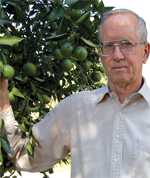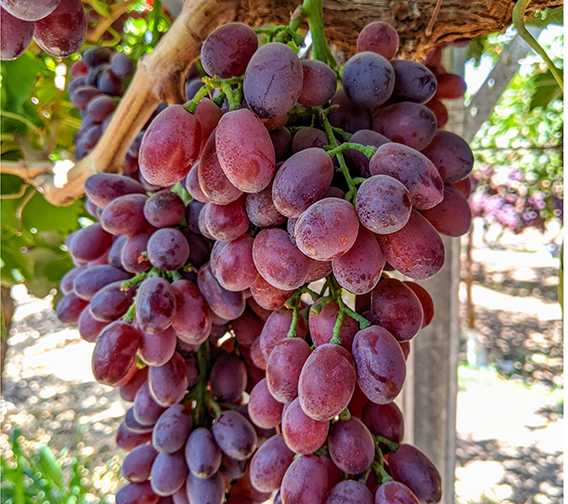Windbreaks Work For Florida Citrus Grower

The Vero Beach grower was concerned because of the threat canker posed to the east coast of Florida’s fresh-market grapefruit industry.
“I was retired and kind of out of the picture until 2005 when I saw canker and greening creating such a threat,” says Edsall. “I felt like I needed to get back involved, because if we don’t find solutions to these diseases, they are going to run us out of business.
“When we realized windbreaks were critical in living with canker, especially with susceptible citrus like grapefruit, I traveled to Argentina and Australia to observe how they use windbreaks.”
Bill Castle, scientist at the Univeristy of Florida, Citrus Research and Education Center in Lake Alfred, is studying whether windbreaks make sense for Florida citrus.
“My colleagues and I have been stating, based on anecdotal evidence from elsewhere in the world, that windbreaks are essential for fresh fruit,” Castle says. “In Florida, evidence among grapefruit growers seems to strongly support that contention. Windbreaks also make sense for juice and fresh-fruit growers of early-season varieties because they are relatively susceptible.
“I don’t know the percentage of growers using windbreaks in Florida, but it’s very low at the moment. However, interest is beginning to pick up, and the list of growers looking at windbreaks is expanding every day. For example, there is one grower who is considering planting 26 miles of eucalyptus.”
Windbreak Believers
Since his dad, Bob Sr., started planting groves after World War II, Edsall’s groves have been known for windbreaks.
“My dad was a big believer in windbreaks,” says Edsall. “People could pick out our groves by the windbreaks of Australian pine surrounding them.”
Like his father, Edsall believes windbreaks are critical to the survival of fresh-market citrus producers today.
“Canker is a great threat to us, and my feeling is that windbreaks are our only choice right now,” he says. “Where canker is not yet established or is just getting established, we should try to get ahead of it with windbreaks.”
In addition to windbreaks, growers have to do other things right in the fight against canker including spraying with copper, utilizing solid sanitation programs, controlling leafminer, and hand pruning infected foliage. Edsall learned this in his travels to Argentina to see how its grapefruit industry was combating canker.
“You have to be doing all of these things to control canker in grapefruit, and it is very expensive,” says Edsall. “We are going to need to be getting $7 to $9 per box back on a tree to pay for it. I recently heard an economist tell us we can expect $4 to $4.50 per box on fresh grapefruit this year. That’s not going to cut it.”
The Aussie Connection
Australian pines have been recognized as good windbreaks, and according to Edsall, the Cunningham Australian pine (Casuarina cunninghamiana) is probably the best. There is just one problem — Australian pines are banned in Florida by the state’s Department of Environmental Protection (DEP).
There are three types of Australian pine in Florida, and they are all banned as invasive species. But Edsall says the Cunningham pine is getting a bad rap because of the heavy seed-producing, invasive nature of its cousin Casuarina equisetifolia.
“In southern Florida, the Casuarina equisetifolia has become a pest, particularly south of Lake Okeechobee,” he says. “They produce an awful lot of seed and have become a pest, which is why DEP has a distaste for Australian pines. However, the Cunningham pine has been around a long time, and we’ve not seen any evidence that it has invasive qualities.”
The Best Pine For The Job
According to Edsall, the Cunningham pine is by far the best windbreak tree for citrus, and it is no wonder that it is the most widely used windbreak tree in the world.
“In Argentina, they have found the Cunningham pine to be the best since they started planting windbreaks in the 1970s,” he says. “In Australia and South Africa, they don’t have canker, but they plant the tree to protect against wind scar. As a windbreak, the Cunningham pine gets a grade A, with all the features we want.”
Other Options
There are other options for windbreaks, such as Grevillea robusta (silk oak), Eucalyptus grandis, bamboo, and man-made structures. Edsall has purchased silk oak transplants and is storing them in citrapots in his greenhouse over the winter. In late May or early June, when the rainy season starts, the silk oaks will be planted in his groves as windbreaks.
“Grevillea robusta do grow fast (6 feet per year) and are not overly competitive with citrus,” Edsall says. “However, I wouldn’t normally be planting them because they are sensitive to cold temperatures and break up in strong winds. We are not that enthusiastic about planting the trees, but it is an indication how important we feel it is to have windbreaks.”
Edsall says Eucalyptus grandis is currently planted along the north and south edges of around 400 acres of the 1,200 acres of their groves.
“Our acreage is only partially protected since the internal lines of trees that will run east and west across the north and south ends of each 20-acre block have not been planted yet,” he says. “We would like to avoid putting the Eucalyptus grandis in the internal lines, because of its very aggressive growth and root system. We believe the tree would be helpful at first, but after six to eight years, its roots would be troublesome and the lower canopy would be too open.”
Edsall says he doesn’t like bamboo because it acts as an impermeable wind barrier, causing great turbulence in high winds, which can damage citrus trees. He says windbreaks that act as a baffle are more effective, allowing 30% to 40% of wind to pass through.
Clearing The Way For Cunningham
Edsall, and other industry leaders, have taken their desire to remove the ban on Cunningham pines to Tallahassee. At their behest, Florida House Ag Committee member Ralph Poppell (R-29th District) has sponsored legislation to remove the ban.
“I’ve asked people to show me where the Cunningham pine has been a problem anywhere in the world across multiple soil types and climates,” says Poppell. “Nobody has been able to show me where it has been a problem. It is a good tree, and in my opinion, not invasive.”
Poppell’s legislation would provide a comfort zone for those who still have concerns about the Cunningham pine.
“If a grower decides to put the Cunningham pine in his groves as a windbreak, he would need a special permit and would have to keep record of the trees he planted under my proposal,” says Poppell. “If the property is not being maintained for commercial citrus production, or if the DEP determines the trees are a problem, then the landowner would be responsible for removing the trees before the land could be sold.”
According to Poppell, he believes the legislation has a good chance at passage during the next session, opening the door for growers to use the Cunningham pine as a windbreak in their fight against disease.










